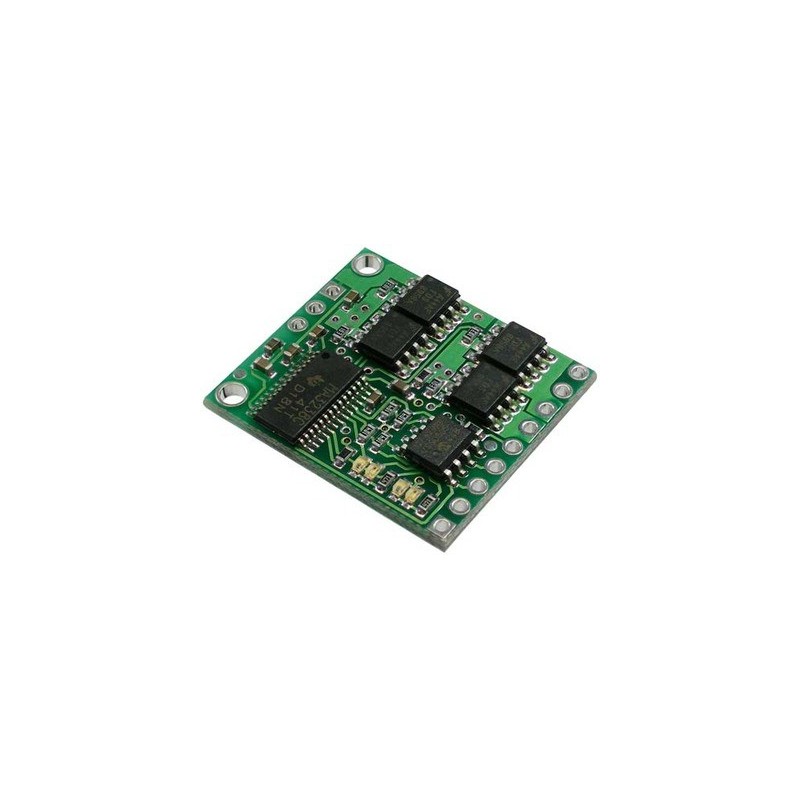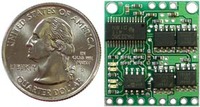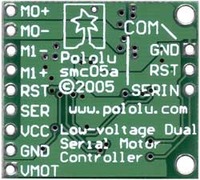

Pololu Low-Voltage Dual Serial Motor Controller
Frustrated by those cheap, low-voltage motors that require too much current? Here’s the answer: a low-voltage motor controller designed specifically for those toy motors. With all of the convenience of the Pololu dual serial motor controllers and the added ability to deliver 5 amps per motor with no minimum motor voltage, this dual serial motor controller has you covered.
 |
This low-voltage version of our dual serial motor controller (DSMC) is designed specifically for high-performance, low-voltage toy motors that run on 1.5 - 6 V. Because they run at lower voltages, these motors have higher current requirements, making them difficult to control since most integrated motor drivers are designed either for low-current, low voltage motors (such as those in CD players or cameras) or for higher-voltage motors that run at 6 volts or more. With this latest motor controller, you can consider a whole new range of motors for your next project.
Because of the unique design of the low-voltage motor controller, there is no minimum motor supply voltage, meaning that a motor can be run off of a single cell until it is completely discharged. In a typical application, two to five Ni-Cd or Ni-MH cells can be used throughout their discharge cycle. The motor controller can deliver up to 5 A continuously to each channel, without a heat sink, and like our other dual serial motor controllers, the two output channels can be coupled to deliver up to 10 A to a single load. Since many small Mabuchi motors (such as those used in the Tamiya gearboxes) have stall currents in the 2 - 4 A range, you can drive them to the limits of their performance.
 |
In addition to the motor supply, the controller requires an independent 3.0 - 5.5 V logic supply, which can be higher or lower than the motor supply voltage. This can be useful if you have 3 V motors that you would like to run off of two or three cells but have 5 V logic. If you do have a single supply that satisfies both requirements (which would typically mean 3 or 4 cells), the motor controller can be powered off of a single supply. Each motor has a corresponding pair of LEDs that light up without the motor supply to let you troubleshoot your code without your robot driving away.
The 9-pin module is pin-compatible and code-compatible with our micro dual serial motor controller, making it easy to upgrade your existing robot to higher performance. The low-voltage motor controller shares all of the features of the micro motor controller except for coasting: setting speeds of 0 in forward or reverse will result in braking.
Please note that the low-voltage motor controller can become very hot during operation; observe proper precautions around a running unit. A heatsink can improve performance, but it is not required. The motor controller does not feature over-current or over-temperature shutdown. Applying reverse battery polarity or attempting to draw too much current will cause permanent damage to the motor controller.
For high-current applications, make sure to use the thickest and shortest wires possible. Make sure your motors have 0.1 uF capacitors installed across their leads to limit noise and interference with your other electronics. Make sure that your battery can deliver the current that you attempt to draw: typically, you should have at least 1 amp-hour of capacity per 10 amps you draw (which would give you about five minutes of operating time).
Note: This product no longer ships with a printed user’s manual. The user’s manual can be downloaded as a pdf from the resources tab of this product page.
 |
Tamiya 70144 Ball Caster Kit (2 casters) |
 |
Tamiya 70097 Twin-Motor Gearbox Kit |
 |
Tamiya 70101 Truck Tire Set (4 tires) |
Producent BTC Korporacja sp. z o. o. Lwowska 5 05-120 Legionowo Polska sprzedaz@kamami.pl 22 767 36 20
Osoba odpowiedzialna BTC Korporacja sp. z o. o. Lwowska 5 05-120 Legionowo Polska sprzedaz@kamami.pl 22 767 36 20
Dwukanałowy (mostek H) sterownik silników z układem L298, zgodny z Arduino, napięcie zasilania silnika 4,8-35VDC/2A. Może sterować jednym lub dwoma silnikami DC lub jednym silnkiem krokowym z możliwością użycia hamulca elektronicznego. DFRobot DRI0009
Waveshare DDSM Driver HAT (B) to zaawansowany sterownik silników piastowych DDSM400, oparty na ESP32, z obsługą komunikacji przewodowej (USB, UART) i bezprzewodowej (WiFi, ESP-NOW). Umożliwia sterowanie do 6 silników z wykorzystaniem poleceń JSON i integrację z Raspberry Pi, co czyni go odpowiednim rozwiązaniem dla robotyki mobilnej i projektów systemów wielosilnikowych.
Nakładka przeznaczona do użycia z płytkimi z serii Feather zawiera dwa układy TB6612 pozwalające na sterowanie silnikami prądu stałego lub silnikami krokowymi. Do komunikacji z nakładką wykorzystywany jest interfejs I2C. Adafruit 2927
Sterownik silnika krokowego A4988 operujący na napięciach 8..35 V i prądzie 1,2 A. Pololu 2981
Moduł ze sterownikiem silnika krokowego oparty na układzie DRV8434A. Pozwala na zasilanie silnika bipolarnego prądem do 1,2 A na fazę i napięciem od 4,5 V do 45 V. Komunikacja przez interfejs SPI. Pololu 3768
Brak towaru
A4988 Stepper Motor Driver Carrier with Voltage Regulators
Sterownik silników DC, który pozwala na kontrolowanie ruchu dwóch napędów za pomocą interfejsu I2C. Płytka ze złączami do montażu. Pololu 5052
Brak towaru
Dwukanałowy sterownik silników DC o napięciu pracy od 7 do 35 V i prądzie ciągłym do 30 A. Może być sterowany sygnałem analogowym, PWM, UART, RC lub za pomocą wbudowanych przycisków. Cytron MDDS30
Sterownik silników DC, który pozwala na kontrolowanie ruchu trzech napędów za pomocą interfejsu I2C. Złącza do samodzielnego montażu. Pololu 5034
Kompaktowy sterownik silnika krokowego z układem TMC2208 o napięciu pracy od 4 do 35 V. Oferuje płynną, cichą pracę, wysoką wydajność, różnorodne tryby pracy oraz łatwą konfigurację. Jest sterowany przez interfejs STEP/DIR i stanowi idealne rozwiązanie dla drukarek 3D oraz podobnych zastosowań
Brak towaru
Mostek H umożliwiający sterowanie jednym silnikiem DC w obu kierunkach lub dwoma jednokierunkowymi przy napięciu od 4,5 do 44 V i prądzie ciągłym do 1,3 A. Moduł oferuje trzy tryby pracy (PH/EN, IN/IN, półmostki), wbudowane ograniczenie i pomiar prądu oraz zabezpieczenia przed przegrzaniem, przeciążeniem, zbyt niskim napięciem i odwrotną polaryzacją. Dzięki kompaktowej budowie, elastycznemu zasilaniu logiki (1,8–5,5 V) i prostemu sterowaniu świetnie sprawdza się w robotyce, automatyce i projektach hobbystycznych. Pololu 4971
Dwukanałowy sterownik ESC do silników szczotkowych. Może dostarczyć prąd o natężeniu 40 A i ma przewody zakończone złączem XT60
Jednokanałowy sterownik silników DC z interfejsem I2C. Jest zasilany napięciem od 1,8 V do 22 V i może dostarczyć prąd o natężeniu do 1,8 A. Płytka ze złączami do montażu. Pololu 5075
Moduł sterownika silnika bezszczotkowego (regulator ESC) o wydajności prądowej do 35 A
Moduł ze sterownikiem silnika DC DRV8256P. Może współpracować z silnikami zasilanymi napięciem od 4,5 do 48 V i poborze prądu do 1,9 A. Pololu 4039
Brak towaru
DRV8801 Single Brushed DC Motor Driver Carrier

Pololu Low-Voltage Dual Serial Motor Controller
